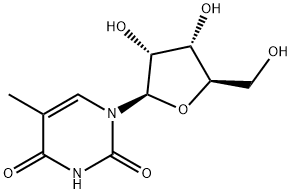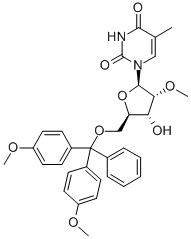PRODUCT Properties
| Melting point: | 183-184 °C(lit.) |
| Density | 1.576±0.06 g/cm3(Predicted) |
| storage temp. | Keep in dark place,Sealed in dry,Room Temperature |
| solubility | Methanol (Slightly, Heated, Sonicated), Water (Sparingly, Sonicated) |
| pka | 9.55±0.10(Predicted) |
| form | powder |
| color | white |
| PH | 9.7 |
| λmax | 267 (pH 1);268 (pH 13) |
| InChI | InChI=1S/C10H14N2O6/c1-4-2-12(10(17)11-8(4)16)9-7(15)6(14)5(3-13)18-9/h2,5-7,9,13-15H,3H2,1H3,(H,11,16,17)/t5-,6-,7-,9-/m1/s1 |
| InChIKey | DWRXFEITVBNRMK-JXOAFFINSA-N |
| SMILES | OC[C@H]1O[C@@H](N2C=C(C)C(=O)NC2=O)[C@H](O)[C@@H]1O |
| CAS DataBase Reference | 1463-10-1(CAS DataBase Reference) |
Description and Uses
5-Methyluridine is a pyrimidine nucleoside and methylated form of uridine. It is the ribonucleoside counterpart to the deoxyribonucleoside thymidine, which lacks a hydroxyl group at the 2' position. 5-Methyluridine contains a thymine base joined to a ribose pentose sugar. It is an endogenous methylated nucleoside found in human fluids. In cells, 5-methyluridine is present in tRNA, formed during its post-transcriptional modification by the methylation of uridine.
A primary degradation product of tRNA, an urinary nucleoside as biological marker for patients with colorectal cancer.
It enhances the antitumor activity of 5-fluorouracil in a mouse Erlich solid carcinoma model and a P388 murine leukemia model. It has been used to characterize the activity of a variety of enzymes, including uridine nucleosidase.
Safety
| Symbol(GHS) |  GHS07 |
| Signal word | Warning |
| Hazard statements | H302-H315-H319-H335 |
| Precautionary statements | P261-P305+P351+P338 |
| Hazard Codes | T+ |
| Risk Statements | 26/27/28 |
| Safety Statements | 24/25 |
| WGK Germany | 3 |
| HS Code | 29349990 |






